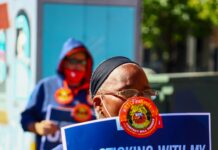A new study by the University of California’s Berkeley Center for Labor Research And Education confirms what many of us have long suspected–the great majority of those on welfare actually do work. Specifically, almost 75 percent of those who are on Medicaid, food stamps and other programs geared toward the poor are members of families that have at least one worker among them.

The report, entitled “The Public High Cost of Low Wages,” makes for horrifying reading at times. It is the first comprehensive study of how much the nation’s safety net actually costs. Center director Ken Jacobs and his team found that between them, the states and federal government spend $152.8 billion on public assistance for families that have at least one member working at least 27 weeks per year and 10 hours per week. It also found that 56 percent of state and federal money spent on public assistance programs goes to working families.
It gets even worse when you break down individual programs. A whopping 61 percent of participants in Medicaid and the Children’s Health Insurance Program from 2009 to 2011 came from working families. Of the 28 million people receiving the Earned Income Tax Credit during that same period, all but eight million were from working families.
Jacobs told The New York Times that the huge number of working families who have to turn to welfare is “a hidden cost of low-wage work.” Taxpayers wind up footing the bill for the gap between low-wage workers’ paychecks and basic living expenses. In effect, this means companies that rely heavily on low-wage workers are being subsidized by the rest of us.
The Times interviewed several workers who need public assistance programs just to make it. Adriana Alvarez, a cashier at a McDonald’s in Chicago, needs Medicaid, a child-care subsidy and food stamps even though she earns well above the minimum wage. Her struggles are familiar to most fast-food workers, 52 percent of whom are on public assistance. The pinch is even harder for her because her three-year-old son, Manny, is lactose intolerant–and his milk eats up most of her $80 monthly allotment of food stamps. Denise Rush, a home health aide in Durham, earns only $700 every two weeks. Even with Medicaid and $300 per month in food stamps, Rush still finds it hard to make ends meet.
This report should give more ammunition to those calling for an increase in the minimum wage. Indeed, Jacobs and his team found that wages have more or less flatlined in the last 30 years. The median wage in 2013 was only five percent higher than it was in 1979–nowhere near enough to keep up with inflation. Even before this report came out, lawmakers in some states have already begun efforts to turn the hot lights on companies that have a large number of low-wage workers. For instance, a bill pending in Connecticut would require employers to pay a fee for every worker who earns less than $15 per hour. Next year, California will begin publishing the names of employers who have more than 100 workers on Medicaid.
I had initially thought that Walmart was the prime example of what I like to call “deadbeat capitalism”–willful disregard of an employer’s basic duty to ensure its workers can live decently without public help. But if more than half of public assistance money is spent on the working poor, that mentality is more widespread than even I suspected. After reading this report, I don’t ever want to hear anything about “moochers” and “welfare queens” ever again. Those shibboleths have been thrown around by right-wingers for more than three decades–and now stand comprehensively debunked by this report.





